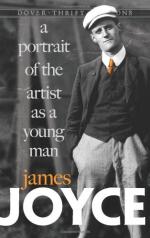|
|
A Portrait of the Artist as a Young Man Notes & Analysis
The free A Portrait of the Artist as a Young Man notes include comprehensive information and analysis to help you understand the book. These free notes consist of about 50 pages (14,937 words) and contain the following sections:
These free notes also contain Quotes and Themes & Topics on A Portrait of the Artist as a Young Man by James Joyce.
A Portrait of the Artist as a Young Man Plot Summary
The novel tells the story of the first twenty years of Stephen Dedalus--a young Catholic boy growing up in late 19th century Ireland. As the title suggests, this is the story not just of a young man, but of a boy developing into an artist. The book opens in Stephen's nursery with two pages of prose that were revolutionary for the time. It then chronicles the political and religious pulls on this generally good-hearted and naïve little boy, both those of his family and his classmates and teachers at Clongowes, an all-boys school run by Jesuit priests (Part 1). Next, Stephen goes to Belvedere College, where he is a model student, though a bit alienated and increasingly tormented by a bodily lust that eventually drives him to a prostitute (Part 2). The first prostitute is not the last, and Stephen is plunged into a life of serious Catholic sin, though he repents after a series of sermons delivered at a religious retreat at his school (Part 3). Stephen does a complete turnaround after the retreat and devotes himself to God, attracting the attention of the director of the school, who proposes to Stephen that he join the priesthood, a call that Stephen, after a little initial prideful excitement, declines (Part 4). He goes instead to the university, where his classmates and teachers treat him as a budding poet, and the novel ends with Stephen having made the commitment to be an artist, though not having actually created much in the way of art (Part 5).
James Joyce first wrote Portrait as a one-thousand page novel, full of well-developed scenes and long explanations of Stephen's motives, but he decided to trim it into a short book with a new sort of style. Joyce's ambition was to hang a story on a series of important incidents. Although these incidents are presented chronologically, there is often no transition from scene to scene. Among the more important of these scenes are:
- Stephen in his nursery, trying to make sense of his surroundings;
- a Christmas dinner at the Dedalus house with two guests--Dante Riordan and Mr. Casey--where a huge fight about religion breaks out;
- Stephen being asked by the bully at school whether he kisses his mother before he goes to bed and being confused when he's laughed at for answering 'yes';
- Stephen being unfairly hit by a priest and then telling on this priest;
- Stephen wanting to kiss a girl, Emma, on a tram ride but not doing it;
- Stephen traveling to Cork with his father and feeling alienated from his own father and his friends;
- Stephen winning an essay prize and feeling empty after he squanders all the money; Stephen's first trip to a prostitute;
- his transformation by sermons given at a religious retreat;
- his confession of his sins;
- his refusal of the priesthood;
- his moment of "epiphany" when he sees a beautiful girl wading on the beach and declares he'll commit himself to art;
- and his creation of his first poem.
More happens between these scenes but the point is that Joyce shows Stephen's growth not by a connected story but through a series of illuminating moments.
More important than a continuous story is the evolution of Stephen's mind and sensibilities as shown by his responses to these illuminating moments. If you listen to the sound of the prose and the organization of Stephen's thoughts, you can feel that he's growing older. For example, in his nursery, happenings are reported as so: "When you wet the bed first it is warm then it gets cold. His mother put on the oilsheet. That had a queer smell" (pg. 3). As a boy at Clongowes, Stephen's thoughts sound boyish: "Rody Kickham was a decent fellow but Nasty Roche was a stink" (pg. 4). By the time Stephen gets to the university, the sound of the prose is completely different--it's long and flowing and full of big but elusive ideas, like Stephen's own mind. It's also important to pay attention to the rhythm of the story. Each section ends on a high note, with Stephen's emotional elation, but the start of the following section is always flat, as Stephen comes to terms with his often grim and dirty life in Dublin.
The book ends on the upswing--closing with a series of entries from Stephen's diary that show he has made the decision to live his life as an artist. It's unclear, however, whether he will succeed at this. He's got lots of big ideas but has only completed one poem, and the poem isn't all that good. If the pattern of the book were extended past the last chapter, the old fall into griminess would be next. Critics argue about whether Joyce was sympathetic toward Stephen and saw him as a young version of himself, ready to take on the world as an artist, or if the author had an ironic attitude toward his character and wanted readers to see him as a poser, a boy who has given all of his energy to talking about art without ever really creating any. No one has come up with a decisive answer to the question of Joyce's intentions. Perhaps guessing at what fate awaits Stephen as an artist is less important than seeing the decisions a young person must make in order to commit himself or herself to the idea of life as an artist.




